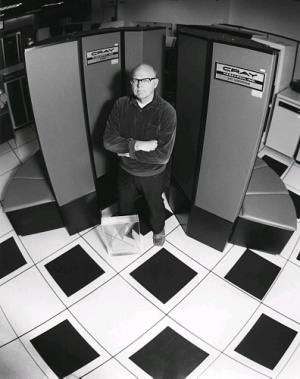Difference between revisions of "Cray X-MP"
GerdIsenberg (talk | contribs) (Created page with "'''Home * Hardware * Cray X-MP''' FILE:3-2b.LLNL.Cray_Blitz.Nelson-Harry.19XX.L062302003.LLNL.srcl.lg.jpg|border|right|thumb|300px|link=http://www.compute...") |
GerdIsenberg (talk | contribs) |
||
| Line 30: | Line 30: | ||
=Publications= | =Publications= | ||
| − | * [https://en.wikipedia.org/wiki/Steve_Chen_%28computer_engineer%29 Steve S. Chen], [ | + | * [https://en.wikipedia.org/wiki/Steve_Chen_%28computer_engineer%29 Steve S. Chen], [[Mathematician#JDongarra|Jack Dongarra]], [http://dblp.uni-trier.de/pers/hd/h/Hsiung:Christopher_C= Christopher C. Hsiung] ('''1984'''). ''Multiprocessing linear algebra algorithms on the CRAY X-MP-2: Experiences with small granularity''. [http://dblp.uni-trier.de/db/journals/jpdc/jpdc1.html#ChenDH84 Journal of Parallel Distributed Computing], Vol. 1, No. 2, [http://www.netlib.org/utk/people/JackDongarra/PAPERS/009_1984_multiprocessing-linear-algebra-algorithms-on-the-cray-x-mp-2.pdf pdf] |
* [[Harry Nelson]] ('''1984'''). ''How We Won The Computer Chess World's Championship''. Excerpt from a talk given at he DAS Computer Science Colloquium, [http://archive.computerhistory.org/projects/chess/related_materials/text/3-1%20and%203-2.Nelson-Harry.Cray-Blitz.How_we_won.Jan-1984/Nelson-Harry.Cray-Blitz.How_we_won.Jan-1984.062303020.pdf pdf] from [[The Computer History Museum]] » [[WCCC 1983]] | * [[Harry Nelson]] ('''1984'''). ''How We Won The Computer Chess World's Championship''. Excerpt from a talk given at he DAS Computer Science Colloquium, [http://archive.computerhistory.org/projects/chess/related_materials/text/3-1%20and%203-2.Nelson-Harry.Cray-Blitz.How_we_won.Jan-1984/Nelson-Harry.Cray-Blitz.How_we_won.Jan-1984.062303020.pdf pdf] from [[The Computer History Museum]] » [[WCCC 1983]] | ||
* [[Robert Hyatt]] ('''1985'''). ''Parallel Chess on the Cray X-MP/48''. [[ICGA Journal#8_2|ICCA Journal, Vol. 8, No. 2]] | * [[Robert Hyatt]] ('''1985'''). ''Parallel Chess on the Cray X-MP/48''. [[ICGA Journal#8_2|ICCA Journal, Vol. 8, No. 2]] | ||
Latest revision as of 22:01, 31 October 2018
Cray X-MP,
a supercomputer designed, manufactured and marketed by Cray Research Inc., announced in 1982 as successor of the Cray-1. It was the world's fastest computer from 1983 to 1985 [2]. Its principal designer was Steve Chen. The X-MP's main improvement over the Cray-1 was a shared-memory, parallel vector processor, housing two CPUs in a mainframe that was nearly identical in outside appearance to the Cray-1. The X-MP CPU had a faster 9.5 nanosecond clock cycle (105 MHz), compared to 12.5 ns for the Cray-1. It was built from bipolar gate array integrated circuits containing 16 emitter-coupled logic gates each, and was very similar to the Cray-1 CPU in architecture, and object-code compatible [3]. In 1984, improved models of the X-MP were announced, consisting of up to four-processor systems.
Contents
Cray-2
The Cray-2 was a supercomputer with four vector processors built with emitter-coupled logic starting in 1985. It was the fastest machine in the world when it was released, replacing the Cray X-MP in that spot [4].
Cray Y-MP
X-MP successor Cray Y-MP was sold by Cray Research from 1988, retained software compatibility with the X-MP, but extended the address registers from 24 to 32 bits. The Y-MP could be equipped with two, four or eight vector processors [5].
Cray C90
The Cray C90 series (Y-MP C90) was a vector processor supercomputer launched by Cray Research in 1991. The series included the C94, C98 and C916 models with a maximum of four, eight, and 16 processors respectively [6].
Chess Programs
See also
Manuals
Publications
- Steve S. Chen, Jack Dongarra, Christopher C. Hsiung (1984). Multiprocessing linear algebra algorithms on the CRAY X-MP-2: Experiences with small granularity. Journal of Parallel Distributed Computing, Vol. 1, No. 2, pdf
- Harry Nelson (1984). How We Won The Computer Chess World's Championship. Excerpt from a talk given at he DAS Computer Science Colloquium, pdf from The Computer History Museum » WCCC 1983
- Robert Hyatt (1985). Parallel Chess on the Cray X-MP/48. ICCA Journal, Vol. 8, No. 2
- Robert Hyatt (1988). A High-Performance Parallel Algorithm to Search Depth-First Game Trees. Ph.D. Thesis, Department of Computer Science, University of Alabama at Birmingham
- Melvin C. August, Gerald M. Brost, Christopher C. Hsiung, Alan J. Schiffleger (1989). Cray X-MP: The Birth of a Supercomputer. IEEE Computer, Vol. 22, No. 1
- Robert Hyatt, Bruce W. Suter, Harry Nelson (1989). A Parallel Alpha-Beta Tree Searching Algorithm. Parallel Computing, Vol. 10, No. 3.
- Robert Hyatt, Harry Nelson (1990). Chess and supercomputers: details about optimizing Cray Blitz. Supercomputing '90, pdf
- Robert Hyatt (1994). The DTS high-performance parallel tree search algorithm.» Dynamic Tree Splitting
- Robert Hyatt (1997). The Dynamic Tree-Splitting Parallel Search Algorithm. ICCA Journal, Vol. 20, No. 1
Forum Posts
- hardware of Cray Blitz by Leonid, CCC, June 13, 1999 » WCCC 1983
- Cray and supercomputers (kinda long) by Joshua Shriver, CCC, September 16, 2005
- Cray Blitz source (Carey) by Robert Hyatt, CCC, September 10, 2008
External Links
- Cray X-MP from Wikipedia
- Category: Cray X-MP - Wikimedia Commons
- Cray (brand) from Wikipedia
- Cray, the Supercomputer Company | Cray"
- Cray Super Computers - Cray XMP
- CRAY X-MP/48 from SCD Supercomputer Gallery
- High Performance Computer Architectures: A Historical Perspective - The CRAY X-MP
- Cray-2 from Wikipedia
- Cray Y-MP from Wikipedia
- Cray C90 from Wikipedia
References
- ↑ Harry Nelson, co-developer of chess program Cray Blitz, in front of Cray supercomputer, 1983 ca., Courtesy of Lawrence Livermore National Laboratory, The Computer History Museum
- ↑ Cray X-MP from Wikipedia
- ↑ Cray X-MP from Wikipedia
- ↑ Cray-2 from Wikipedia
- ↑ Cray Y-MP from Wikipedia
- ↑ Cray C90 from Wikipedia
